Abstract
In the context of global climate change, it is urgent to understand how Amazonian forests will be affected by more frequent and intense climatic extremes, such as drought and inundation. Water availability is strongly correlated to tree diversity in tropical forests and is one of the most important drivers of tree community assembly. Within the project ATTO HydroTraits, our main goal is to investigate the vulnerability of abundant tree species along a gradient of drought duration and intensity across different Amazonian ecosystems.
To this aim, we will use a unique and extensive dataset covering four study sites located in the Northeastern and Eastern Amazon, including the ATTO site, along a gradient of increasing dry season length. We will inventory tree species in three common forest ecosystems (terra firme, igapó floodplain forest, and white-sand ecosystems) and leverage functional trait data from abundant tree species. By covering different forest ecosystems, we expect to improve our understanding of the ecology of the different Amazonian forest types and explore which tree species and habitats are most vulnerable to extreme hydro-climatic extremes which are increasing in magnitude and frequency in the Amazon basin.
So far, we did fieldwork campaigns at two research sites. We went to the Uatumã Sustainable Development Reserve (ATTO site and Abacate River), where we measured the functional traits and NIRS in 30 tree species across the habitats at the permanents plots of the research group MAUA. We did a field campaign to the lower Xingu River where we established new research plots, inventoried tree species, and measured functional traits and NIRS at terra firme and igapó forests.
Objectives
Our main goals are:
- To investigate how tree species composition and taxonomic diversity change along a gradient of increasing drought across forest ecosystems.
- To investigate how functional traits and plant hydraulic strategies of the most abundant tree species in each of the ecosystems change along the drought gradient.
- To investigate how tree growth of the most important tree species relates to environmental and climatic site conditions.
- To build up spectral libraries of functional traits using near-infrared field spectroscopy (NIRS) in order to enhance trait detection in the field.
Team
HydroTraits is a sub-project of ATTO+ – Earth System and Climate Studies at the Amazon Tall Tower Observatory. It is a collaboration between the Karlsruhe Institute of Technology (KIT, Germany) and the research group MAUA (Ecology, Monitoring, and Sustainable Use of Wetlands) from the National Institute for Amazonian Research (INPA, Brazil) and has synergies with the PELD project (Brazilian Long-term Ecological Network) and the network REDE RIPÁRIA.
- Prof. Dr. Florian Wittmann, KIT / Aueninstitut Rastatt, Germany (PI)
- Prof. Dr. Jochen Schöngart, INPA Manaus, Brazil (Coordinator in Brazil)
- Prof. Dr. Maria Teresa F. Piedade, INPA Manaus, Brazil
- Prof. Dr. Susan Trumbore, MPI-BGC Jena, Germany
- Dr. Flávia M. Durgante, KIT / Aueninstitut Rastatt, Germany
- Dr. Gisele Biem Mori, KIT / Aueninstitut Rastatt, Germany
- Dr. Adriano Costa Quaresma, KIT / Aueninstitut Rastatt, Germany
- Dr. Layon Oreste Demarchi, INPA, Manaus, Brazil
- Dr. Eliane Gomes Alves, MPI-BGC, Jena, Germany
- Ms. Hilana Hadlich, PhD candidate from INPA, Manaus, Brazil
- Ms. Carolina Mallmann, UFSM, Santa Maria, Paraná, Brazil
- Ms. Carolina Vasconcelos, INPA, Manaus, Brazil
- Ms. Priscila Amaral de Sá, INPA, Manaus, Brazil
- Ms. Maíra Luciana Guimarães Conde, INPA, Manaus, Brazil
- Ms. Michelle Robin, MPI-BGC, Jena, Germany
- Bs. Glória Vieira Rodrigues, INPA, Manaus, Brazil
- Bs. Sant Cler Andrade, INPA, Manaus, Brazil





